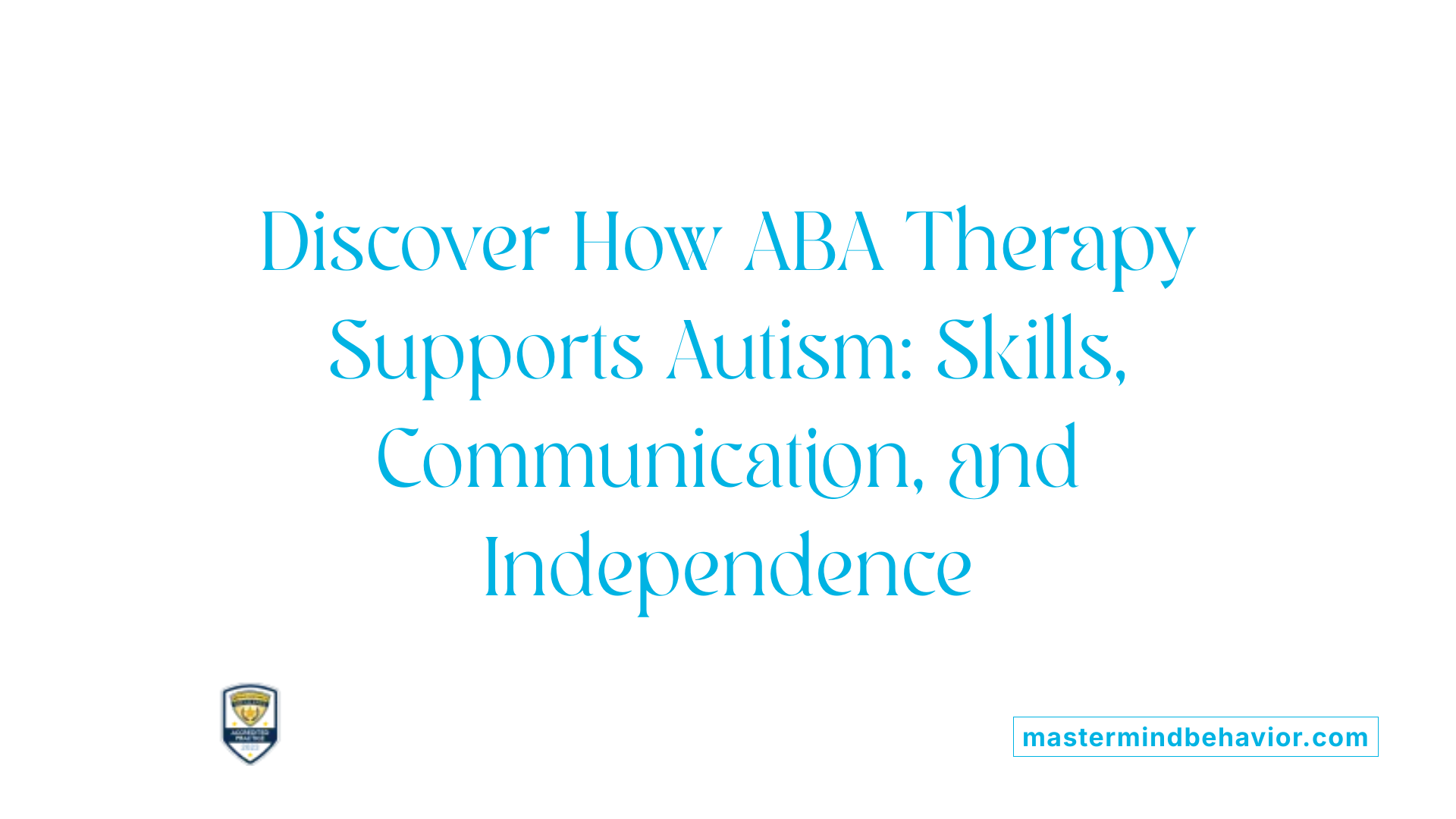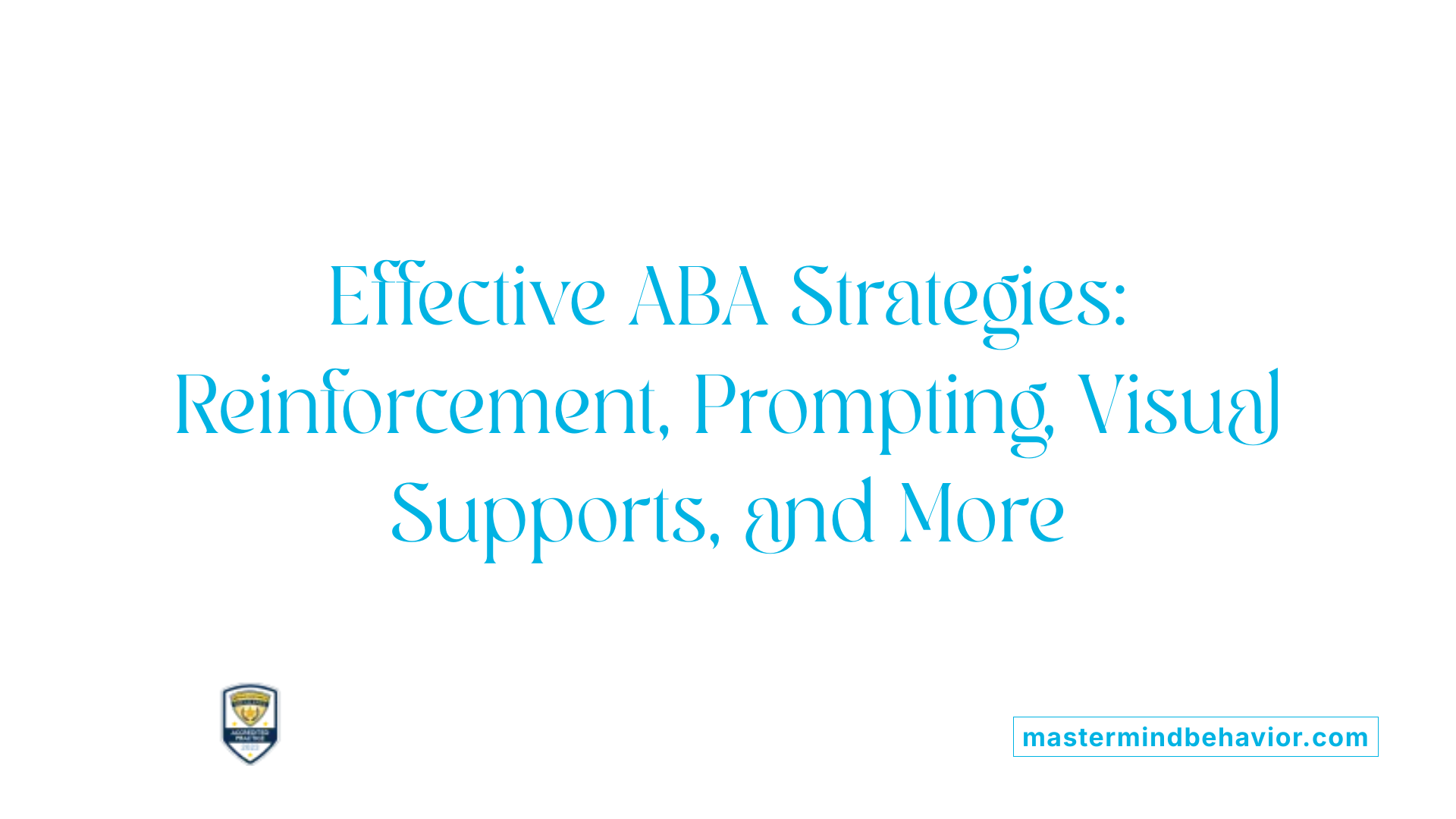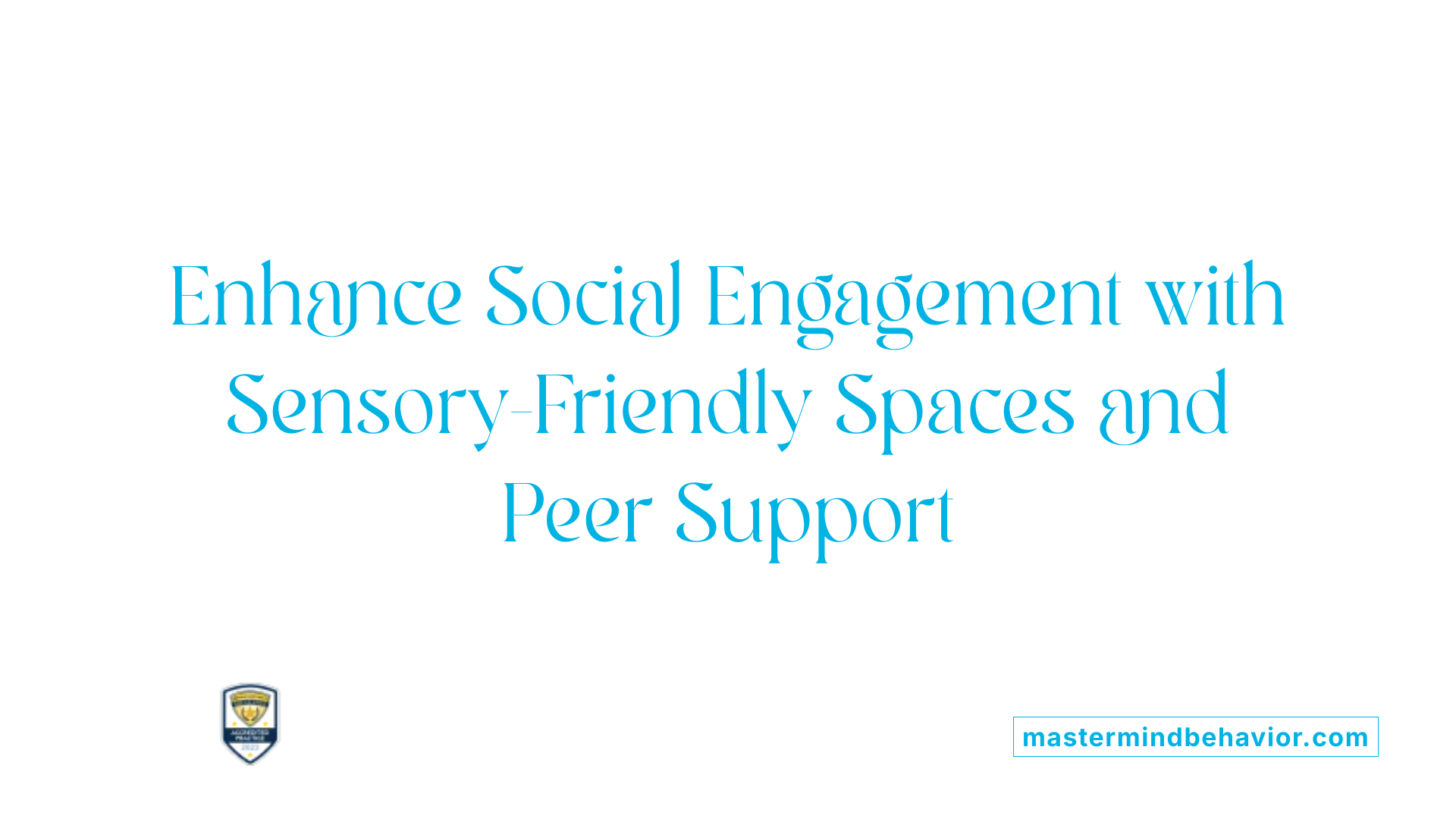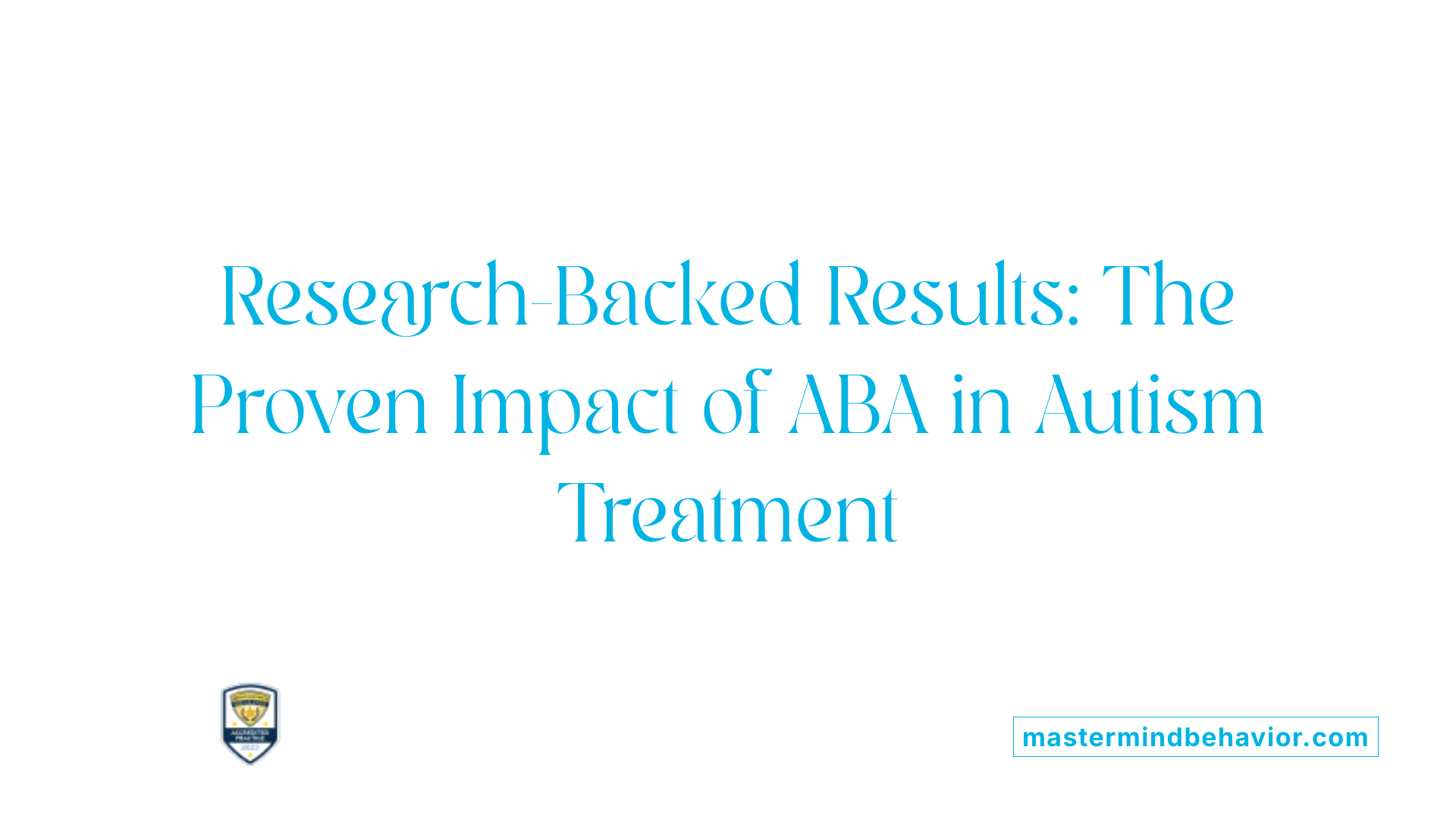ABA Therapy To Reduce Disruptions During Group Activities

Understanding ABA Therapy and Its Importance in Group Settings
Applied Behavior Analysis (ABA) therapy has become a cornerstone in supporting children with autism, especially in managing behaviors that could disrupt group activities. By using evidence-based behavioral strategies, ABA not only helps children adjust to group dynamics but also fosters essential social skills and smoother transitions. This article explores how ABA therapy reduces disruptions during group activities, the techniques involved, and the critical role of collaboration among caregivers and educators to promote inclusive, supportive environments.
What Is ABA Therapy and How Does It Help Individuals with Autism?

What Is Applied Behavior Analysis (ABA) Therapy?
Applied Behavior Analysis (ABA) therapy is an evidence-based approach designed to support individuals with autism. It focuses on understanding behaviors by examining how the environment influences them and uses strategies to promote positive actions. ABA is centered on teaching new skills and improving existing ones through structured and personalized methods.
Focus and Goals of ABA Therapy
ABA therapy aims to improve essential areas such as social interaction, communication, language, and daily living skills. It works by reinforcing desirable behaviors using techniques like positive reinforcement, prompting, and breaking tasks into manageable steps. This focus helps reduce behaviors that may interfere with learning or social engagement.
Individualized Approach to Care
A key aspect of ABA therapy is its customization. Programs are tailored to each child’s needs, abilities, and developmental stage. Certified professionals, such as Board Certified Behavior Analysts (BCBAs), design and oversee interventions that may incorporate various teaching styles like discrete trial training or play-based methods. This personalized approach ensures that therapy is effective and meets the unique needs of each learner.
Benefits for Group Participation and Independence
Early, intensive ABA therapy enhances skills that support successful group participation, such as turn-taking, sharing, and communication. As children learn to manage behaviors and acquire new skills, they often experience improved independence and quality of life. Through consistent practice and reinforcement, ABA helps individuals with autism build confidence to engage more fully in social settings and everyday activities.
Qualified Providers: Who Delivers ABA Therapy?

Who typically provides ABA therapy for individuals with autism?
ABA therapy is delivered by a team of qualified professionals dedicated to supporting children with autism. At the forefront are Board Certified Behavior Analysts (BCBAs), who design and oversee individualized treatment plans based on detailed behavior assessments. They ensure that the therapy aligns with evidence-based practices and monitors progress through regular data collection.
What professional roles are involved in ABA therapy?
Besides BCBAs, Registered Behavior Technicians (RBTs) and other trained behavior therapists carry out daily therapy sessions under BCBA supervision. These technicians work directly with children to reinforce positive behaviors, teach new skills, and implement strategies adjusted to each child's needs.
Where is ABA therapy typically provided?
ABA services can be offered in multiple settings, including the child's home, school, and community environments. Flexibility in the setting helps tailor the therapy to real-life situations and fosters generalization of skills across contexts.
Why is it important to consider providers’ credentials?
Ensuring the team has appropriate training and certification guarantees adherence to high-quality, evidence-based interventions. Families are encouraged to ask about the provider’s credentials, experience working with autism, and their specific therapeutic approach.
How does family involvement integrate with professional delivery?
Family collaboration is a fundamental aspect of ABA therapy. Professionals work closely with parents and caregivers to maintain consistency, reinforce strategies, and support progress beyond therapy sessions. This teamwork helps maximize the benefits of ABA and promotes skill development in everyday life.
Techniques Used in ABA to Support Positive Behavioral Changes

What are common techniques used in ABA therapy to support behavioral changes?
Applied Behavior Analysis (ABA) therapy uses several evidence-based strategies to encourage positive behavioral changes in children with autism. One of the most effective methods is positive reinforcement, which involves rewarding desired behaviors to increase their frequency. This can include praise, tokens, or other rewards tailored to the child’s preferences.
Prompting is another key technique, where cues or assistance are given to encourage a behavior, followed by gradual fading to promote independent skill use. This helps children learn new tasks step-by-step without becoming dependent on help.
Visual supports play a critical role in ABA by making instructions or routines clearer. These supports can include picture cards, charts, or video modeling, enabling children to understand and imitate complex behaviors more easily.
Behavior chaining breaks down complicated skills into smaller, manageable actions taught sequentially until the full behavior is mastered.
To reduce challenging behaviors, ABA often uses extinction, which works by withholding reinforcement for the unwanted behavior, leading to its decrease over time.
Additional strategies include behavior contracts that outline expectations and consequences, script fading for social interactions, redirection to guide attention away from negative behaviors, and the ABC (Antecedent-Behavior-Consequence) approach that analyzes what triggers behaviors and their results.
ABA techniques are highly individualized and combined based on data to foster meaningful, sustainable improvements across social, communication, and daily living skills for children with autism.
Customizing ABA Interventions for Individual Needs
How does ABA therapy customize interventions for each individual?
ABA therapy begins with thorough assessments to understand each child's unique strengths, challenges, and preferences. This process involves observations, interviews, and standardized tools to gain a clear picture of the child's abilities and needs.
From these assessments, therapists create personalized treatment plans that set specific, measurable, achievable, relevant, and time-bound (SMART) goals. These plans utilize targeted strategies such as prompts, positive reinforcement, and activity-based learning tailored to the child's age, communication style, and interests.
Ongoing progress is carefully monitored through data collection techniques like ABC (Antecedent-Behavior-Consequence) recording and frequency counts. This allows therapists to make real-time adjustments to the intervention plan, ensuring it remains effective and relevant.
Collaboration with families and educators plays a crucial role in maintaining consistency across various environments. Regular communication and training help caregivers and teachers reinforce skills and behaviors learned during therapy sessions.
Additionally, technology such as telehealth platforms and digital tools provide flexible and engaging options, allowing interventions to adapt as the child's needs evolve over time.
ABA Strategies to Reduce Disruptions During Group Transitions
How do visual schedules and timers help during group transitions?
Visual schedules and timers are effective ABA tools that prepare children for upcoming changes by clearly outlining what to expect next. Visual supports like picture cards and charts break down routines into understandable segments, reducing anxiety and confusion. Timers provide a concrete signal for when a transition is approaching, enabling children to anticipate and mentally prepare for the change.
What role does priming play in easing transitions?
Priming involves giving children advance notice or 'heads-up' about upcoming transitions. This strategy helps children mentally prepare by reducing uncertainty and stress. By alerting them ahead of time, they can adjust expectations and behaviors smoothly, minimizing disruptions during group activities.
How do first-then statements and task choices aid transitions?
First-then statements clarify expectations by specifying the sequence of activities, such as "first finish cleaning up, then play." This clear language provides structure and predictability. Offering task modifications or choices gives children a sense of control, making transitions less intimidating and more manageable. These strategies use positive reinforcement to motivate children to complete tasks and move through transitions successfully.
How does ABA support the development of independent self-regulation?
ABA therapy aims to teach children self-regulation strategies over time, enabling them to handle transitions independently. By reinforcing positive behaviors and breaking tasks into smaller steps, children learn to manage changes with less assistance. Consistent collaboration between ABA therapists, families, and educators ensures these skills are practiced across environments, promoting greater autonomy during group activities.
Supporting Group Participation Through Sensory and Social Supports

Creating Sensory-Friendly Spaces
Sensory-friendly environments play a crucial role in helping children with autism participate comfortably in group activities. These spaces are designed to minimize sensory overload by controlling noise levels, lighting, and activity pacing. This helps children remain focused and engaged without becoming overwhelmed.
Use of Sensory Tools Like Headphones and Weighted Blankets
To further support sensory needs, tools such as noise-canceling headphones, fidget toys, and weighted blankets are commonly used. Headphones reduce disruptive background noises, helping children concentrate. Weighted blankets provide calming deep pressure, which can reduce anxiety and promote emotional regulation. These tools empower children to manage their sensory experiences proactively.
Encouraging Peer Relationships and Buddy Systems
Fostering positive peer relationships is essential for social development. Group activities and buddy systems encourage children to interact, collaborate, and build friendships. These approaches provide structured opportunities for social engagement, helping children with autism practice social skills in a supportive setting.
Social Skills Development in Group Settings
Group participation also offers an excellent platform to develop social skills. ABA programs emphasize teaching social communication, cooperation, and turn-taking through targeted activities. Ongoing support from educators and therapists, combined with positive reinforcement, helps children build confidence and competence in social interactions within groups.
Evidence for ABA's Effectiveness in Autism Intervention

What evidence exists demonstrating the effectiveness of ABA therapy for autism?
Applied Behavior Analysis (ABA) is widely recognized as an evidence-based intervention for individuals with autism. Numerous research studies and meta-analyses have confirmed its effectiveness in improving communication, social skills, and adaptive behaviors. These studies often include randomized controlled trials that report significant improvements in expressive language, intellectual functioning, and overall socialization for children undergoing ABA therapy.
Research studies and meta-analyses
Multiple meta-analyses highlight the robust positive impact ABA therapy has on a range of developmental areas for children with autism. For example, effect sizes from these analyses show notable gains in IQ scores, language acquisition, and communication abilities. This scientific backing underpins the widespread use of ABA across various clinical settings.
Improvements in communication and social skills
ABA uses positive reinforcement strategies to encourage desired behaviors, including improvements in communication and social interaction. Structured ABA programs emphasize teaching new skills and reinforcing social engagement. Through consistent therapy, many children develop better ways to express themselves and interact effectively with peers and adults.
Long-term benefits for group integration
Children receiving ABA interventions often show better integration in social groups over time. Through skill development and behavioral teaching, ABA helps foster independence and self-regulation, which are crucial for participation in group activities and collaborative learning environments.
Examples of structured ABA programs
Several structured ABA-based programs such as the Early Start Denver Model and the Picture Exchange Communication System (PECS) illustrate ABA’s practical applications. These programs tailor interventions to each child’s needs, promoting communication and social skills with measurable outcomes. Although some differences exist in study results, the overall consensus supports the effectiveness of ABA models in improving key developmental areas for children with autism.
| Aspect | Description | Impact on Autism Intervention |
|---|---|---|
| Research Evidence | Meta-analyses and randomized controlled trials | Demonstrates ABA's efficacy across core skills |
| Communication Improvements | Use of positive reinforcement to enhance language | Leads to better expressive and receptive abilities |
| Social Skill Development | Teaching social behaviors and interaction techniques | Facilitates peer relationships and group participation |
| Structured Programs | Early Start Denver Model, PECS | Provide systematic approaches with measurable outcomes |
Optimizing ABA Therapy: Duration, Frequency, and Educator Training
What is the typical duration and frequency of ABA therapy sessions?
ABA therapy usually involves 20 to 40 hours of sessions per week tailored to each child's unique needs. This intensive approach spans several months to years, with longer durations often resulting in more significant improvements, particularly in language and academic abilities.
Why is intensity and early intervention important?
Starting ABA therapy early, generally around ages 2 or 3, boosts the effectiveness of the intervention. The number of weekly therapy hours—its intensity—plays a critical role; more hours can speed up skill mastery and developmental gains. Early and consistent intervention lays a strong foundation for ongoing progress.
How does ongoing training for educators support ABA therapy?
Educators and therapists benefit greatly from continued training in programs like the Incredible Years Teacher Autism program. These trainings keep them updated on best practices, helping providers adapt strategies to each student's evolving needs and ensuring interventions remain effective over time.
What role does collaboration play in implementing best practices?
Successful ABA therapy hinges on strong collaboration among therapists, families, and educators. Working together promotes consistent use of strategies across environments, enhances communication, and deepens understanding of the child's progress. This teamwork supports smoother transitions and reinforces the skills learned during therapy.
Collaborative ABA Strategies Enhance Group Success
ABA therapy offers a powerful, individualized framework that equips children with autism to better navigate social group environments by reducing behavioral disruptions and promoting positive participation. Through tailored interventions, visual supports, sensory accommodations, and consistent collaboration among therapists, families, and educators, children develop skills critical for smooth transitions and social engagement. Research underscores ABA's effectiveness in improving communication, behavior, and independence, laying the foundation for more inclusive, supportive group settings. Ultimately, integrating ABA strategies fosters an environment where children with autism can thrive alongside peers, enriching their experiences and promoting community inclusion.
References
- How ABA Therapy Can Help Autistic Children Manage ...
- Effective Classroom Strategies for Teaching Students with ...
- The effectiveness of applied behavior analysis program ...
- Efficacy of Interventions Based on Applied Behavior ...
- The effectiveness of applied behavior analytic interventions ...
- ABA Techniques: Strategies for Behavior Analysts - GSEP Blog
- ABA Therapy Examples, Definition & Techniques
- Applied Behavior Analysis (ABA)
Recent articles

ABA Therapy For Increasing Peer Engagement During Play
Enhancing Social Interaction in Autism Through Play-Based ABA Therapy

ABA Therapy For Increasing Peer Engagement During Play
Enhancing Social Interaction in Autism Through Play-Based ABA Therapy

Support Options for Adults With Autism Through ABA And Related Services
Comprehensive ABA and Support Services Empower Adults with Autism

How ABA Therapy Encourages Creative Play And Imagination
Unleashing Creativity: The Role of ABA Therapy in Enhancing Play and Imagination

How ABA Therapy Supports Healthy Daily Transitions At Home
Bridging Challenges: ABA Therapy's Role in Smooth Home Transitions for Children with Autism

How ABA Therapist Uses Data To Adjust Behavior Plans
Data-Driven Insights: Shaping Effective ABA Behavior Plans



